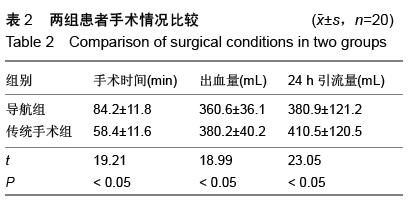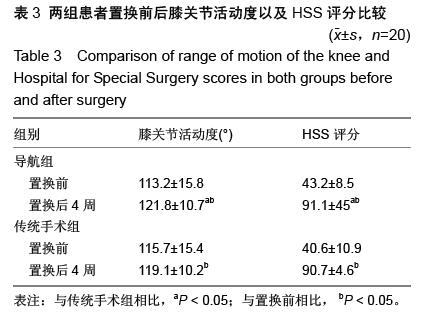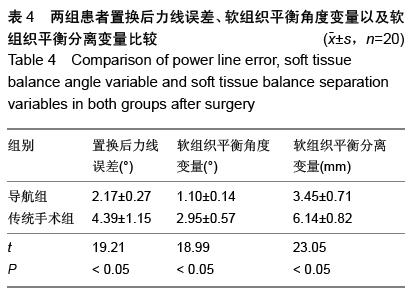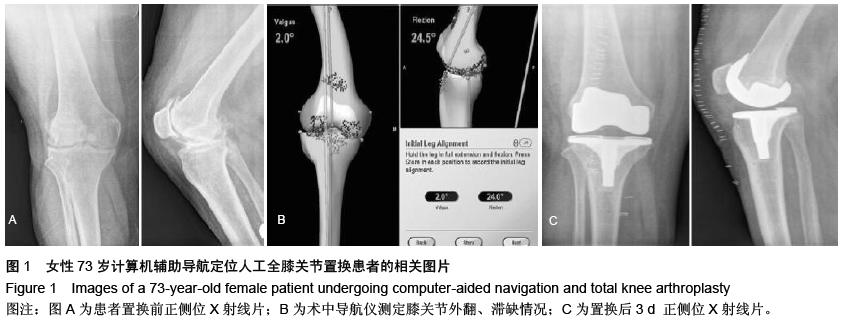| [1] 郇松玮,姚平,刘宁,等. 膝关节置换术后不同镇痛方案的疗效评价[J].中国矫形外科杂志,2014,22(7):601.
[2] 蔡猛,徐海斌.人工膝关节置换术后深静脉血栓形成的研究进展[J]. 新乡医学院学报,2014,31(3):232.
[3] 糜丽梅,吴姗,张毓洁,等.人工膝关节置换术后感染的危险因素分析[J].中华医院感染学杂志,2014,24(7):1715-1719.
[4] Hoffart HE,Langenstein E,Vasak N. A prospective study comparingthe functional outcome of computer - assisted and conventional totalknee replacement. J Bone Joint Surg Br. 2012;94(2) :194.
[5] 冯世庆,曹富江,张宏志,等. 胸腰段骨折常见问题分析及计算机导航在手术中的应用[J].中国矫形外科杂志,2008, 16(10): 724.
[6] Schmidt C,Liljenqvist U,Lerner T,et al. Sagittal balance of thoracic lordoscoliosis: anterior dual rod instrumentation versus posterior pedicle screw fixation. Eur Spine. 2011;20(7): 1118.
[7] Tsukeoka T,Tsuneizumi Y,Lee TH. The effect of the posterior slope of the tibial plateau osteotomy with a rotational error on tibial component malalignment in total knee replacement. Bone Joint J. 2013;95-B(9): 1201-1203.
[8] Harman MK,Banks SA,Kirschner S,et al. Prosthesis alignment affects axial rotation motion after total knee replacement :a prospective in vivo study combining computed tomography and fluoroscopic evaluations. BMC Musculoskelet Disord. 2012;13 :206.
[9] Tashiro Y,Uemura M,Matsuda S,et al. Articular cartilage of the posterior condyle can a ect rotational alignment in total knee arthroplasty.Knee Surg Sports Traumatol Arthrosc. 2012;20(8): 1463-1469.
[10] van der Linden-van der Zwaag HM,Bos J,van der Heide HJ,et al. A computed tomography based study on rotational alignment accuracy of the femoral component in total knee arthroplasty using computer- assisted orthopaedic surgery. Int Orthop. 2011;35(6): 845-850.
[11] 张闻,邵俊杰,张先龙.计算机导航对人工全膝关节置换术下肢旋转对线的影响[J].中华骨科杂志,2008,28(10): 819-823.
[12] Niki Y,Matsumoto H,Hakozaki A,et al.Rheumatoid arthritis: a risk factor for deep venous thrombosis after total knee arthroplasty Comparative study with osteoarthritis. J Orthop Sci. 2010;15(1): 57-63.
[13] 王维军,牛东生.重症类风湿性关节炎膝关节屈曲挛缩畸形全膝关节置换术的软组织平衡[J].中国修复重建外科杂志,2008,22(10):1173-1176.
[14] Yano K,Ikari K,Inoue E,et al. Effect of total knee arthroplasty on disease activity in patients with established rheumatoid arthritis:3-year follow-up results of combined medical therapy and surgical intervention. Mod Rheumatol. 2010;20(5):452-457.
[15] Parvizi J,Rapuri VR,Saleh KJ,et al. Failure to resurface the patella during total knee arthroplasty may result in more knee pain and secondary surgery. Clin Orthop Relat Res. 2005;438: 191-196.
[16] Schrama JC,Espehaug B,Hallan G,et al. Risk of revision for infection in primary total hip and knee arthroplasty in patients with rheumatoid arthritis compared with osteoarthritis: a prospective, population-based study on 108,786 hip and knee joint arthroplasties from the Norwegian Arthroplasty Register. Arthritis Care Res (Hoboken). 2010;62(4): 473-479.
[17] 孙铁铮,吕厚山.晚期类风湿关节炎合并膝关节强直或僵直畸形行人工膝关节置换术[J].中华关节外科杂志:电子版,2011,5(1):3-9.
[18] 卜延民,于建华,赵秀祥,等.采用保留后交叉韧带旋转半月板假体人工全膝关节置换治疗类风湿性关节炎的临床研究[J].中国修复重建外科杂志,2010,24(6): 696-700.
[19] 郭卫,王现海,李大森,等.肿瘤型人工膝关节置换治疗膝关节骨肉瘤疗效及并发症分析[J].中华外科杂志, 2007, 45(12): 825-828.
[20] 童培建,李陶冶,俞楠泽,等.全膝关节置换术治疗甲型血友病性膝关节炎的短期疗效分析[J].中华外科杂志, 2010, 48(10):796-797.
[21] Rancourt MF,Kemp KA,Plamondon SM,et al. Unicompart mental knee arthroplasties revised to total knee arthroplasties compared with primary total knee arthroplasties. J Arthroplasty. 2012;27(8 Suppl): 106-110.
[22] Akasaki Y,Matsuda S,Miura H,et al. Total knee arthroplasty following failed high tibial osteotomy: mid-term comparison of posterior cruciate- retaining versus posterior stabilized prosthesis. Knee Surg Sports Traumatol Arthrosc. 2009;17(7):795-799.
[23] Stulberg SD,Loan P,Sarin V. Computer-assisted navigation in total knee replacement: results of an initial experience in thirty-five patients.Bone Joint Surg (Am).2011; 84(Suppl2): 90-98.
[24] Eckhoff DG,Bach JM,Spitzer VM,et al. Three - dimensional mechanics,Kinematics,And morphology of the knee viewed in virtual reality. Bone Joint Surg(Am). 2011; 87(Suppl2):71-80
[25] 韩伟.人工膝关节置换治疗重症膝关节病118例[J].中国组织工程研究与临床康复,2009,13(35):6995-7000.
[26] 谢正阳,侍勇,刘志元.人工膝关节在运动性损伤中的应用[J].中国组织工程研究与临床康复,2010,14(22): 4093-4096.
[27] 孙鲁宁,蔡文辉,沈计荣.人工全膝关节置换术后肌力锻炼对假体膝关节功能的作用[J].中国临床康复,2003,7(32): 4415-4418.
[28] 胡金萍.几种高分子生物材料屏障作用预防肌腱粘连的系统评价[J].中国组织工程研究与临床康复, 2009, 13(29): 5793-5797.
[29] 王庆丰.武术运动踝关节骨损伤原理与组织工程学康复术[J].中国组织工程研究与临床康复,2011,14(38): 7153-7156.
[30] Handl M,Drzik M,Cerulli G,et al. Reconstruction of the anterior cruciate ligament: dynamic strain evaluation of the graft. Knee Surg Sports Traumatol Arthrosc. 2007; 15(3): 233-241.
[31] 党培业,牛东生,白志刚.全膝关节置换治疗膝关节高度屈曲畸形的临床研究[J]. 宁夏医学杂志,2010,32(4): 349-350.
[32] Kock HJ,Sturmer KM,Letsch R,et al. Interface and biocompatibility of polyethylene terephthalate knee ligament pros theses. A his tological and ultras tructural device retrieval analys is in failed synthetic implants used for surgical repair of anterior cruciate ligaments. Arch Orthop Trauma Surg. 2014;114(1):1-7.
[33] 刘渝松,马善治,郭亮,等.中医综合治疗优化方案治疗膝关节骨性关节炎150例临床观察[J].实用中医药杂志, 2012, 28(1):5-8.
[34] 陈大伟,张方建,白书臣,等.中医外治三联法治疗膝骨性关节炎6 0例临床观察[J].中医杂志,2012,53(5):399-332.
[35] 刘建卫,黄培祥.鹿瓜多肽注射液配合中药外洗治疗膝关节骨性关节炎疗效观察[J].中国医学创新,2013,10(1): 133-134.
[36] 林桦楠,陈海鹏.膝关节骨性关节炎关节镜术后注射玻璃酸钠的临床研究[J].中国医学创新,2013,10(3):8-9.
[37] 崔永红,章晓华.玻璃酸钠联合鹿瓜多肽治疗膝关节骨性关节炎疗效观察[J].中国医学创新,2013,10(5):56-57.
[38] 赵钦福,王文,李云,等.关节镜下有效选择性治疗中老年膝关节骨性关节炎[J].中国医学创新,2013,10(8):16-17.
[39] 高升熹,孙爱娟,张鹏,等.全膝关节置换术后应用连续股神经阻滞镇痛和静脉自控镇痛的效果比较[J].中华关节外科杂志,2012,6(1):54-58.
[40] Sakai N,Inoue T, Kunugiza Y,et al. Continuous femoral versus epidural block for attainment of 120° knee flexion after total knee arthroplasty: a randomized controlled trial. J Arthroplasty. 2013;28(5):807-814.
[41] 李灿锋,曾羿,沈彬,等.Quadriceps-Sparing 入路与传统入路全膝关节置换术临床疗效的Meta分析[J].中华关节外科杂志:电子版,2013,7(6):844-851.
[42] 沈灏,张先龙,蒋垚,等.微创全膝关节置换术中不干扰股四头肌和经股内侧肌入路的比较[J].中华关节外科杂志:电子版,2007,1(3):187-192.
[43] 王诗军,张树栋,赵中原,等.计算机导航全膝关节置换术与传统手术的比较[J].中华关节外科杂志:电子版, 2012, 6(5):702-709.
[44] King J,Stamper DL,Schaad DC,et al. Minimally invasive total knee arthroplasty compared with traditional total knee arthroplasty:assessment of the learning curve and the postoperative recuperative period.J Bone Joint Surg Am. 2007;89: 1497-1503.
[45] 沈灏,张先龙,王琦,等. 微创全膝关节置换术的早期临床疗效分析[J].中华外科杂志,2007,45(16):1083-1086. |
.jpg)




